With an extra year of waiting due to the pandemic crisis, the 59th edition of the Venice Biennale of Visual Arts has finally opened to the public under the direction of Cecilia Alemani, the first woman to fill this role for the International Art Exhibition. The milk of dreams, the curatorial theme she has chosen to guide the selection of the exhibition proposals, is taken from a children’s book by Leonora Carrington (1917-2011), in which «the surrealist artist describes a magical world in which life is constantly reinvented through the prism of the imagination and in which it is allowed to change, transform, become other than oneself». As well as historical surrealism reacted to the massacres of the First World War and the imminent horrors of the Second with an exploration of the unconscious animated by mistrust in a system based on rational logic, considered guilty of having generated the political ideologies responsible for the war disasters, also the theme of this exhibition interprets the anxieties of the first quarter of the 21st century in a visionary key, declining them in an unprecedented and predominant feminine point of view.
As usual, the exhibition itinerary of the thematic section is divided between the Central Pavilion in the Giardini and the Arsenale venue, in constant dialogue with the National Pavilions scattered in both locations, as well as in about thirty other locations throughout the lagoon city. As Alemani states, “the exhibition proposes an imaginary journey through the metamorphoses of bodies and definitions of the human” and in fact the collision between organic and inorganic structures as a manifestation of the vulnerability (but also of the adaptability) of the human form emerges as effective leitmotif that connects the different visions of the world present in the exhibition. At the Central Pavilion, entirely dedicated to female artists, amniotic cosmogonies and topographies follow one another and hypothesize a psychic conception of the body in which abstraction and figuration blend with influences derived from nature, craftsmanship and digital technologies. The visitor is immersed in an ambiguous and dystopian atmosphere to which the female connotation of the artists seems to confer a mysterious cathartic power of regeneration. The historical foundation of this conception is made explicit in a room conceived as a real “surrealist incubator” which brings together the works of the putative mothers of the most strictly contemporary artists. Among the most interesting re-discoveries in this section we point out: Josephine Baker (Saint Louis, 1906 – Paris, 1975), American singer and dancer, symbol of redemption for the black community in the Thirties for her conscious humorous deconstruction of the stereotypes referring to African culture, the experimental director Maya Deren (Kiev, 1917 – New York, 1961) and the Czech painter and illustrator Marie Čermínová (Prague, 1902 – Paris, 1980), present with the series of prints The shooting gallery (Střelnice), 1939 – 1940, depicting a rarefied post-war scenario littered with architectural fragments and animal corpses, whose bleak essentiality appears disturbingly in line with the most recent developments in international hostilities in the wake of the conflict between Russia and Ukraine. Confirming Cecilia Alemani’s intent to highlight the existence of a different strand of art history which, emerging from the hidden track, can try to rewrite, at least in part, the balance of power, a precious section dedicated to abstractionist artists active between the 1950s and 1970s (such as Vera Molnar, Carla Accardi, Sonia Delaunay, Marina Apollonio, Laura Grisi and Lillian Schwartz) counterbalances the visionary nature of the surrealists, removing any temptation to uniquely associate the female with a visceral and out of control dimension.
Once these coordinates have been assumed, we then enter the heart of the exhibition, in which the invitation to get lost in favor of the labyrinthine conformation of the exhibition spaces of the Central Pavilion is clear: in the absence of a pre-established visit path, we suggest as an ideal starting point the spectacular video Sirenas (2019-2021) by Nan Goldin, a montage of short clips taken from 30 films by different authors (including Kenneth Anger, Lynne Ramsay, Henri-Georges Clouzot and Federico Fellini) conceived as a tribute to Donyale Luna, name of the American model and actress Peggy Anne Freeman, who was the first black cover girl and one of Andy Warhol’s muses. The work is a glamorous interpretation of the pleasure one feels under the effect of drugs, but also an iconic magnification of the female essence understood as a powerful chthonic divinity. Among the artists on display, in balanced representation between young and mid-career, it seems significant to us to mention: Andra Ursuta, author of seductive sculptures, often made from casts of her body and integrated with everyday objects or waste, Jana Euler, whose painting is configured as an irreverent satire on the human condition through the depiction of grotesque bodies charged with repulsive eroticism, the sculptural alienations by Hannah Levy, which are placed ambiguously between de-functionalized furniture and biological abortion and are similar in formalization to those of Julia Phillips, conceived as assemblies of constriction devices, such as buckles, straps and handles, which return the suggestion of an anonymous and dematerialized body. Instead, the erotic and carnal explanations by Miriam Cahn seem to belong to a sort of violent amorphism, where the “soft”category acquires a treacherous value (here, she presents a dreamlike installation of paintings and works on paper), the sculptures in technical fabric filled with pigmented concrete by Sara Enrico, inspired by the iconography of the suit, invented by the futurist artist Thayaht in 1919 as a garment capable of establishing a harmonious relationship with the body and June Crespo‘s enigmatic sculptural combinations, alluding to dismembered bodies that incorporate industrial materials , clothing and symbolic objects. Finally, we report the performative actions signed by Alexandra Pirici as part of the Encycolpedia of Relations project (2022), in which the performers, understood as living sculptures, combine and recombine gestures open to future additions with the aim of changing semantic structures that reflect on the elusive and ideological nature of communication languages through the materialization of their slippages and inconsistencies.
Now reviewing the proposals of the National participations located in the Giardini venue, the Spanish Pavilion and the German Pavilion stand out for the rigor and essentiality of the project. In the first Ignasi Aballí intervenes on the building by replicating it by means of additional internal walls rotated by 10 degrees with respect to the original plan, so as to align it with the neighboring ones (Belgium and Holland), with respect to which it is slightly inclined. The new structure immerses the visitor in a fascinating mental place that seems to experience in an environmental sense the stylistic rarefaction of Kazimir Malevič’s White Square on a White Background (1918) and at the same time raises disturbing questions about the ideological value of the concepts of cancellation and correction applied to historical memory and its architectural manifestations. The German Pavilion, on the other hand, Maria Eichhorn interprets similar issues in a brutalist key, exposing through excavations and peeling of the layers of plaster of the walls the transformations undergone over time by the structure, built in 1909 as a Bavarian pavilion, renamed as German pavilion in 1912 and redesigned in the 1938 according to the fascist aesthetic canons. The project, completed by a program of visits to places of the Venetian resistance developed in collaboration with the Venetian Institute for the History of Resistance and Contemporary Society (IVESER), invites us to think of urban planning as a system of signs that alternatively increase or reflect the social and political dynamics from which they derive.
Another very suggestive setting is the one designed by Uffe Isolotto for the Denmark Pavilion, where a hybrid environment between the stable and the house is recreated, in which the alienating drama of life and death of a family of centaurs belonging to an indefinite time takes place. The hyperrealism of the characters, a suicidal male centaur and his mother-child companion, the film staging of the set and the insertion of dystopian sculptural details create a visual narrative suspended between ferinity, decadence and fantasy, full of questions about the posthuman. Loukia Alavanou in the Greek Pavilion also offers a saga inspired by mithology in a 360° VR film that can be enjoyed individually by 15 people at a time equipped with special viewers (but the experience fully repays the long wait that you might have to face to enter). Oedipus in Search of Colonus transposes Sophocles’ tragedy into the present to tell the desperate existence of the Rom communities in Nea Zoi, west of Athens. The mixture is explosive: on the one hand the sophisticated cinematographic technologies used by the artist, generating all-encompassing perceptions, have the effect of dematerializing the spectator’s physicality to project him into the heart of the situation that unfolds around him, on the other hand the dust, rags, rubbish and dirt of the place seem to be sublimated by the hieratic recitation of the Rom interpreters who, without distorting their identity, seem to draw their gestures and expressions directly from the sources of the sacred from which the tragedy originated.
The installation of the Estonia Pavilion (exceptionally located in the Danish Pavilion) is also based on the search for a founding myth: Kristina Norman and Bita Ravazi use the metaphor of tropical orchids, whose cultivation was extensively introduced in the small Baltic nation during the Swedish dominion which lasted from the early 16th century until it was ceded to the Russian Empire with the Nystad Treaty of 1721, to bring out the subtle dynamics of exploitation, coercion and osmosis that underlie cultural colonialism. In the Poland Pavilion, on the other hand, Małgorzata Mirga-Tas imagines a very refined Rom cosmogony inspired by the Renaissance astrological frescoes of Palazzo Schifanoia in Ferrara. Twelve large patchwork-tapestries tell the story of the largest minority in Europe and suggest how enchantment can still be an effective tool for re-appropriation of identity and community aggregation.
The projects of the United States of America, Great Britain and France Pavilions choose to tackle the complex issues of the African diaspora, immigration and cultural integration with different declinations with an aesthetic approach that risks slipping into political correctness without really delving into implications that could be raised. In the United States Pavilion, Simone Leigh, winner of the Hugo Boss prize and the first black woman to be entrusted with the Stars and Stripes pavilion, places her monumental figurative sculptures in bronze and ceramic that magnify the strength and nobility of black women interpreting them as idols. The beauty of the forms, derived from a balanced syncretism of inspiration sources, ranging from references to nineteenth-century West African art, the material culture of the first American blacks and the colonial history of international exhibitions, functions as a precise device designed to excite and bewitch the viewer. The Great Britain Pavilion was entrusted to Sonia Boyce, awarded the Golden Lion for best national participation, whose investigation focuses on the search for black female subjectivity in art. The artist, in a very scenographic installation made up of wallpapers with lysergic tessellations, creates a sound space articulated by improvisations and duets of black British vocalists who, embodying feelings of freedom, power and vulnerability, reconnect that particular cultural heritage to praxis of the oral tradition that in the mists of time united African and Western civilizations. Finally, in the French Pavilion Zineb Sedira created a hybrid environment between the film set, the theater and the screening room to explore the reasons for the production of a certain kind of militant films made between the 1960s and 1970s, interpreting them as evidence of the cultural association born in the past between the two shores of the Mediterranean. If the dynamics underlying these cultural intersections leak out from allusions and suggestions unrelated to a specific thread (and perhaps this is precisely the meaning of her reflection), what emerges is a virtuosic metaphor of the cinematic illusion, in which the viewer finds himself trapped in an exponential multiplication of mirrors and citations.
Info:
www.labiennale.org/it/arte/2022
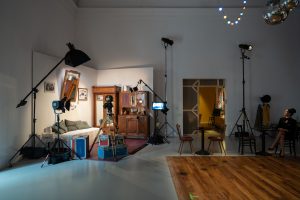 Pavilion of France, Zineb Sedira, Les rêves n’ont pas de titre / Dreams have no titles. 59th International Art Exhibition – La Biennale di Venezia, The Milk of Dreams. Photo by: Marco Cappelletti, Courtesy: La Biennale di Venezia
Pavilion of France, Zineb Sedira, Les rêves n’ont pas de titre / Dreams have no titles. 59th International Art Exhibition – La Biennale di Venezia, The Milk of Dreams. Photo by: Marco Cappelletti, Courtesy: La Biennale di Venezia
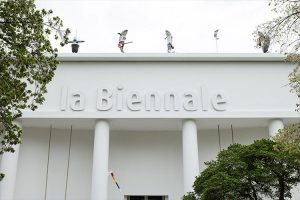 Padiglione Centrale, Giardini, 59th International Art Exhibition – La Biennale di Venezia, The Milk of Dreams. Photo by: Francesco Galli, Courtesy: La Biennale di Venezia
Padiglione Centrale, Giardini, 59th International Art Exhibition – La Biennale di Venezia, The Milk of Dreams. Photo by: Francesco Galli, Courtesy: La Biennale di Venezia
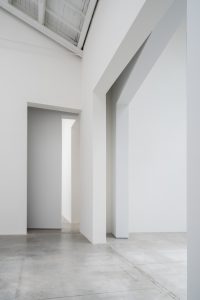 Pavilion of SPAIN, Ignasi Aballí, Correction. 59th International Art Exhibition – La Biennale di Venezia, The Milk of Dreams. Photo by: Marco Cappelletti, Courtesy: La Biennale di Venezia
Pavilion of SPAIN, Ignasi Aballí, Correction. 59th International Art Exhibition – La Biennale di Venezia, The Milk of Dreams. Photo by: Marco Cappelletti, Courtesy: La Biennale di Venezia
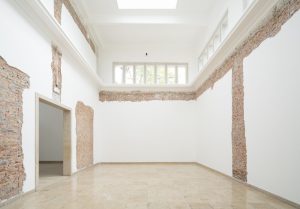 Pavilion of GERMANY, Maria Eichhorn, Relocating a Structure. 59th International Art Exhibition – La Biennale di Venezia, The Milk of Dreams. Photo by: Marco Cappelletti, Courtesy: La Biennale di Venezia
Pavilion of GERMANY, Maria Eichhorn, Relocating a Structure. 59th International Art Exhibition – La Biennale di Venezia, The Milk of Dreams. Photo by: Marco Cappelletti, Courtesy: La Biennale di Venezia
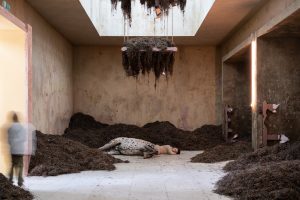 Pavilion of DENMARK, Uffe Isolotto, We Walked the Earth. 59th International Art Exhibition – La Biennale di Venezia, The Milk of Dreams. Photo by: Marco Cappelletti, Courtesy: La Biennale di Venezia
Pavilion of DENMARK, Uffe Isolotto, We Walked the Earth. 59th International Art Exhibition – La Biennale di Venezia, The Milk of Dreams. Photo by: Marco Cappelletti, Courtesy: La Biennale di Venezia
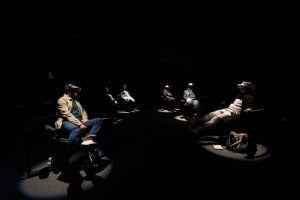 Pavilion of GREECE, Loukia Alavanou, Oedipus In Search of Colonus. 59th International Art Exhibition – La Biennale di Venezia, The Milk of Dreams. Photo by: Marco Cappelletti, Courtesy: La Biennale di Venezia
Pavilion of GREECE, Loukia Alavanou, Oedipus In Search of Colonus. 59th International Art Exhibition – La Biennale di Venezia, The Milk of Dreams. Photo by: Marco Cappelletti, Courtesy: La Biennale di Venezia
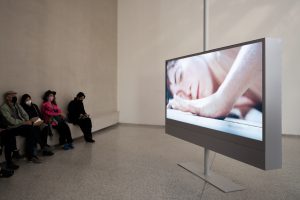 Pavilion of ESTONIA, Kristina Norman, Bita Ravazi, Orchidelirium: An Appetite for Abundance. 59th International Art Exhibition – La Biennale di Venezia, The Milk of Dreams. Photo by: Marco Cappelletti, Courtesy: La Biennale di Venezia
Pavilion of ESTONIA, Kristina Norman, Bita Ravazi, Orchidelirium: An Appetite for Abundance. 59th International Art Exhibition – La Biennale di Venezia, The Milk of Dreams. Photo by: Marco Cappelletti, Courtesy: La Biennale di Venezia
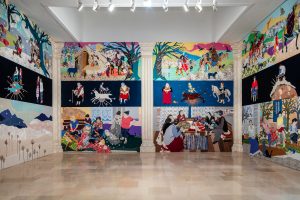 Pavilion of POLAND, Małgorzata Mirga-Tas, Re-enchanting the World. 59th International Art Exhibition – La Biennale di Venezia, The Milk of Dreams. Photo by: Daniel Rumiancew, Courtesy: Zachęta — National Gallery of Art
Pavilion of POLAND, Małgorzata Mirga-Tas, Re-enchanting the World. 59th International Art Exhibition – La Biennale di Venezia, The Milk of Dreams. Photo by: Daniel Rumiancew, Courtesy: Zachęta — National Gallery of Art
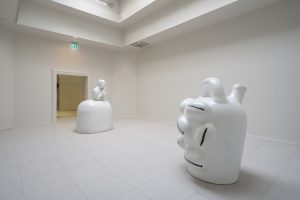 Pavilion of UNITED STATE OF AMERICA, Simone Leigh, Sovereignty. 59th International Art Exhibition – La Biennale di Venezia, The Milk of Dreams. Photo by: Marco Cappelletti, Courtesy: La Biennale di Venezia
Pavilion of UNITED STATE OF AMERICA, Simone Leigh, Sovereignty. 59th International Art Exhibition – La Biennale di Venezia, The Milk of Dreams. Photo by: Marco Cappelletti, Courtesy: La Biennale di Venezia
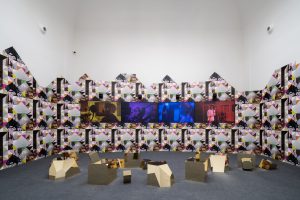 Pavilion of GREAT BRITAIN, Sonia Boyce, Feeling Her Way. 59th International Art Exhibition – La Biennale di Venezia, The Milk of Dreams. Photo by: Marco Cappelletti, Courtesy: La Biennale di Venezia
Pavilion of GREAT BRITAIN, Sonia Boyce, Feeling Her Way. 59th International Art Exhibition – La Biennale di Venezia, The Milk of Dreams. Photo by: Marco Cappelletti, Courtesy: La Biennale di Venezia
Graduated in art history at DAMS in Bologna, city where she continued to live and work, she specialized in Siena with Enrico Crispolti. Curious and attentive to the becoming of the contemporary, she believes in the power of art to make life more interesting and she loves to explore its latest trends through dialogue with artists, curators and gallery owners. She considers writing a form of reasoning and analysis that reconstructs the connection between the artist’s creative path and the surrounding context.


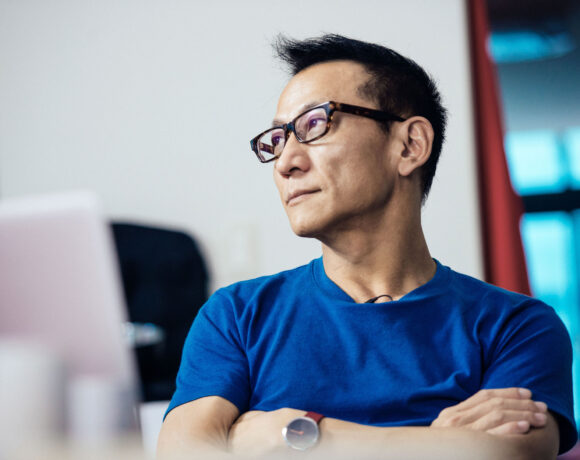
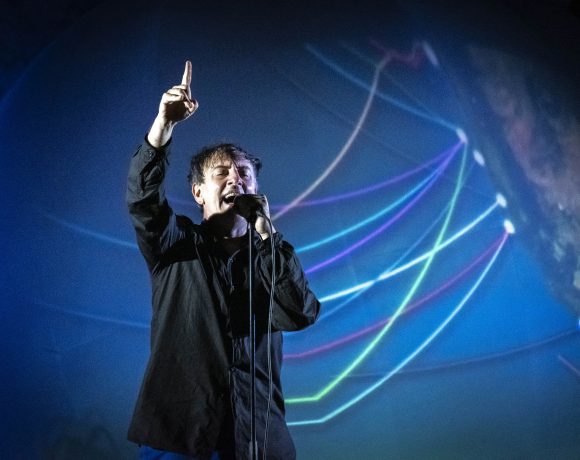
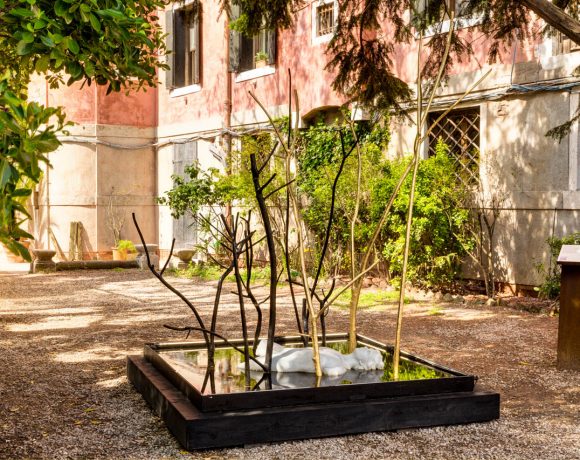

NO COMMENT